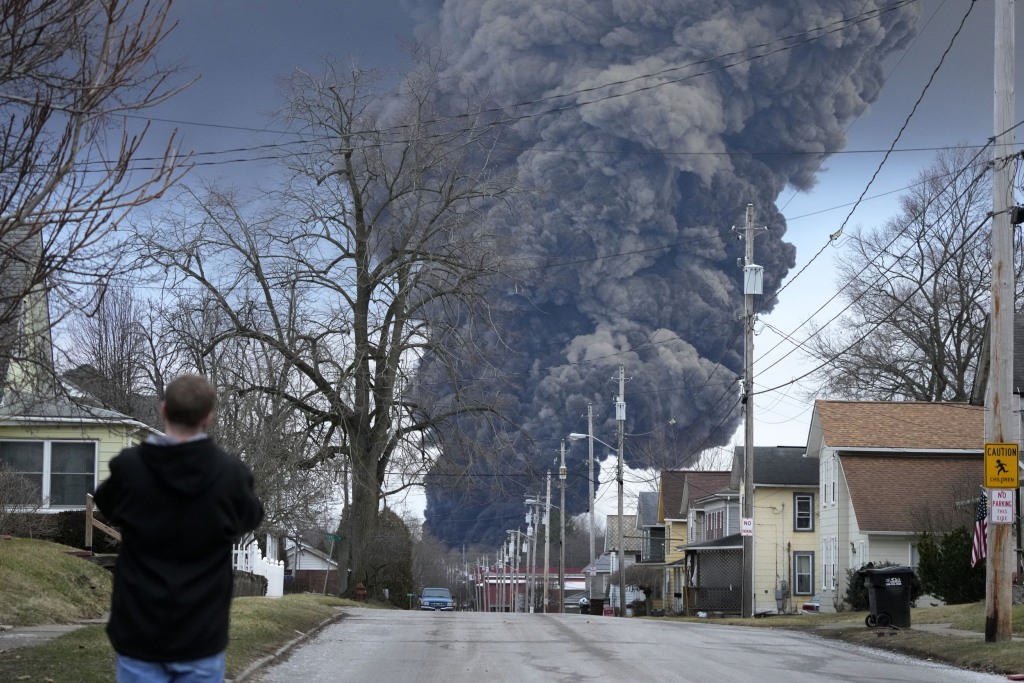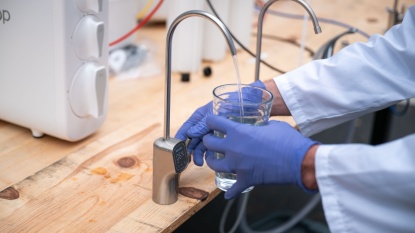It’s brown and burns your eyes. In small town Texas, clean water can be elusive. – The Texas Tribune

Report on Water Infrastructure Deficiencies and Sustainable Development Goal 6 in Texas
Introduction: The Challenge of Ensuring Clean Water and Sanitation for All
The town of Sweeny, Texas, serves as a critical case study illustrating the significant challenges in achieving Sustainable Development Goal 6 (SDG 6: Clean Water and Sanitation) within the United States. Despite being a developed nation, communities like Sweeny face persistent water contamination due to aging infrastructure and inadequate funding mechanisms. This report analyzes the situation in Sweeny and the broader systemic issues in Texas that hinder progress toward providing safe, reliable, and affordable water for all citizens, directly impacting multiple SDGs, including SDG 3 (Good Health and Well-being), SDG 10 (Reduced Inequalities), and SDG 11 (Sustainable Cities and Communities).
Case Study: Sweeny, Texas – A Failure to Meet Basic SDG Targets
Impacts on Health, Well-being, and Household Economy (SDG 3)
Residents of Sweeny experience a severe lack of access to safe drinking water, a fundamental target of SDG 6. The municipal water supply is frequently discolored, foul-smelling, and contaminated with high levels of natural minerals.
- Residents report that the water “burns our eyes when taking a shower” and has caused sickness in both people and animals.
- The lack of trust in tap water forces households to spend hundreds of dollars annually on bottled water for drinking, cooking, and brushing teeth, placing a significant financial burden on families.
- This situation undermines SDG 3 by creating unsanitary conditions, posing health risks, and causing psychological stress from the inability to feel clean.
Root Causes: Infrastructure Decay and Contamination
The primary causes of Sweeny’s water crisis are a combination of aging infrastructure and natural contamination, which the town lacks the financial capacity to address.
- The groundwater supply is contaminated with iron and manganese, with levels of the latter tested at more than three times the recommended limit set by the Texas Commission on Environmental Quality.
- A complete overhaul of the water system is required, but the multi-million dollar cost is beyond the town’s budget, highlighting a critical gap in infrastructure investment necessary for SDG 11.
Systemic Barriers to Achieving SDG 6 in Texas
The Water Infrastructure Funding Gap
An investigation into the Texas Water Board’s state revolving funds reveals a significant disparity between the need for water infrastructure projects and the allocation of financial resources. This gap disproportionately affects small, rural, and disenfranchised communities, exacerbating inequalities in direct opposition to SDG 10.
- High Demand, Low Success Rate: In 2023, the demand for funding far outstripped availability.
- For the Drinking Water fund, 267 communities submitted initial applications, but only 10 ultimately received funding.
- For the Clean Water fund, 170 applications were submitted, but only 11 received funding.
- Insufficient Funding Levels: The U.S. Environmental Protection Agency estimates Texas needs over $3 billion annually to meet its drinking water needs. However, in 2023, the state received only $414 million in federal funds through the state revolving fund program.
Administrative and Financial Hurdles for Small Communities
The process of applying for and accepting state and federal funds presents significant barriers for communities with limited resources, such as Sweeny.
- Complex Application Process: The application requires extensive engineering documents, financial audits, and other detailed information, often with a short 30-day deadline that small municipal governments cannot meet.
- Resource Constraints: Sweeny’s leadership rejected a funding offer with 70% loan forgiveness because the town lacked the administrative capacity to prepare the application in time.
- Political and Financial Unpopularity: Funding often comes as a mix of grants and loans. The requirement to repay loans can necessitate raising local water rates or taxes, which can be politically unpopular, leading municipal leaders to decline assistance that is not a 100% grant.
Broader Implications for Sustainable Development
Climate Change and Future Water Scarcity (SDG 13)
The challenges in Texas are compounded by long-term threats that impact water sustainability and climate resilience, a core component of SDG 13 (Climate Action).
- According to the state’s water plan, Texas’s water demand is projected to increase by 9% by 2070, while the existing water supply is expected to decline by 18%.
- Increasing frequency of extreme weather events, including droughts and floods, will further jeopardize the state’s water resources and strain already fragile infrastructure.
Policy Gaps and Reduced Inequalities (SDG 10)
Current funding policies fail to adequately address inequalities, particularly for disenfranchised neighborhoods within larger cities.
- Funding eligibility for disadvantaged communities is often based on the median household income of an entire city, not specific, low-income census tracts.
- For example, projects in Houston’s low-income Kashmere Gardens neighborhood are deemed ineligible for disadvantaged community funding because the city’s overall median income is too high. This systemic flaw prevents resources from reaching the most vulnerable populations, undermining the core principle of SDG 10.
Proposed Solutions and Remaining Challenges
State-Level Initiatives and the Need for Partnerships (SDG 17)
Texas has initiated programs to address these gaps, but further action and robust partnerships are required to achieve sustainable outcomes.
- Technical Assistance: The Water Utilities Technical Assistance Program was established to help communities apply for funding, providing up to $150,000 to complete the application process.
- New Funding Sources: Proposition 4, a ballot measure, aims to create a dedicated Texas Water Fund with significant long-term investment.
- Advocacy for Policy Change: Environmental groups are advocating for changes to the funding process, such as analyzing median household income by census tract to ensure equitable distribution of funds.
Conclusion
The water crisis in Sweeny, Texas, is not an isolated incident but a symptom of systemic failures in infrastructure investment, funding accessibility, and equitable policy. Achieving SDG 6 requires more than financial allocation; it demands a restructuring of support systems to empower small and disadvantaged communities. Addressing administrative barriers, reforming eligibility criteria to target inequality, and building resilient infrastructure in the face of climate change are essential steps to ensure that the fundamental human right to clean water and sanitation is realized for all citizens.
Analysis of Sustainable Development Goals in the Article
1. Which SDGs are addressed or connected to the issues highlighted in the article?
-
SDG 6: Clean Water and Sanitation
- This is the most central SDG addressed. The entire article focuses on the lack of access to safe, clean, and affordable drinking water for the residents of Sweeny, Texas. The water is described as “brown,” “foul-smelling,” and contaminated with high levels of minerals like manganese and iron, making it untrustworthy for drinking, cooking, or even bathing.
-
SDG 3: Good Health and Well-being
- The article connects poor water quality to negative health outcomes. It mentions a resident’s complaint that the water “smells so much like chlorine it burns our eyes when taking a shower” and another report that “drinking the water caused both her dog and herself to get sick.” This directly relates to ensuring healthy lives and well-being.
-
SDG 10: Reduced Inequalities
- The article highlights significant inequalities. It points out that “communities like Sweeny are often left behind” in funding for water projects. It also describes systemic issues where disenfranchised communities within larger cities, like Kashmere Gardens in Houston, are disadvantaged by funding formulas that consider the entire city’s median income, thus failing to prioritize the most needy neighborhoods.
-
SDG 1: No Poverty
- The lack of safe tap water imposes a direct financial burden on residents, which relates to poverty and economic vulnerability. The article states that residents “spend hundreds of dollars a year on bottled water and refillable jugs.” This extra cost for a basic necessity reduces the disposable income of households, particularly affecting the poor and vulnerable.
-
SDG 11: Sustainable Cities and Communities
- The core issue stems from “aging infrastructure” that cannot provide basic services like safe water. This makes the community of Sweeny less safe, resilient, and sustainable. The article discusses the need for a “much-needed overhaul of Sweeny’s water system,” which is a fundamental aspect of sustainable community infrastructure.
-
SDG 13: Climate Action
- The article places the local water issues within the broader context of climate change. It states that “extreme storms, floods and droughts due to climate change will increase in frequency, putting the state’s water resources in jeopardy.” This highlights the vulnerability of already-strained water systems to climate impacts, connecting the need for infrastructure upgrades to climate resilience.
2. What specific targets under those SDGs can be identified based on the article’s content?
-
Under SDG 6 (Clean Water and Sanitation)
- Target 6.1: “By 2030, achieve universal and equitable access to safe and affordable drinking water for all.” The article clearly shows this target is not being met in Sweeny, where residents lack access to safe tap water and must purchase expensive bottled water, making it neither universally accessible nor affordable.
- Target 6.3: “By 2030, improve water quality by reducing pollution…” The water in Sweeny is described as polluted with high levels of manganese and iron, “more than three times the recommended limit,” directly contradicting the goal of improving water quality.
- Target 6.b: “Support and strengthen the participation of local communities in improving water and sanitation management.” The article notes that residents “sent in pleas for clean water in waves,” indicating a desire for participation. However, the local government’s failure to secure funding shows a breakdown in translating community needs into effective action.
-
Under SDG 3 (Good Health and Well-being)
- Target 3.9: “By 2030, substantially reduce the number of deaths and illnesses from hazardous chemicals and air, water and soil pollution and contamination.” The reports of residents getting sick and experiencing eye irritation from the water directly align with the health risks this target aims to mitigate.
-
Under SDG 10 (Reduced Inequalities)
- Target 10.2: “By 2030, empower and promote the social, economic and political inclusion of all…” The article demonstrates the exclusion of small, rural, and disenfranchised communities from critical funding mechanisms. Sweeny’s inability to even apply for funds due to a lack of resources is a clear example of this exclusion.
-
Under SDG 11 (Sustainable Cities and Communities)
- Target 11.1: “By 2030, ensure access for all to adequate, safe and affordable housing and basic services…” Safe water is a fundamental basic service that is not being provided to the residents of Sweeny, directly challenging the achievement of this target.
3. Are there any indicators mentioned or implied in the article that can be used to measure progress towards the identified targets?
-
Indicator for Water Quality (Target 6.3)
- The article explicitly mentions a quantitative measure of water pollution. It states that the Texas Commission on Environmental Quality found manganese levels in Sweeny’s water were “more than three times the recommended limit.” This measurement serves as a direct indicator of poor water quality.
-
Indicator for Access to Safe Water (Target 6.1)
- The article implies an indicator for the lack of safely managed drinking water services. The widespread practice of residents relying exclusively on bottled water for drinking, cooking, and other household needs could be quantified as the “proportion of the population using bottled water as their primary drinking source due to tap water contamination.”
-
Indicator for Economic Burden (Relates to Target 1.4/6.1)
- The financial impact on residents is stated as spending “hundreds of dollars a year on bottled water.” This amount can be used as an indicator to measure the economic burden and the lack of affordability of safe water.
-
Indicator for Inequality in Funding Access (Target 10.2)
- The article provides specific data that functions as an indicator of systemic barriers. In 2023, “267 Texas communities submitted the initial application for drinking water funding, but only 38 were invited to officially apply… only 10 actually received the funding.” The ratio of applicants to recipients is a clear indicator of the gap between need and resource allocation.
-
Indicator for Financial Gaps in Infrastructure (Relates to SDG 11)
- The article quantifies the gap between required and available funding. It notes that “Texas will need a little over $3 billion annually to address drinking water needs,” but in 2023, it “received just $414 million from the federal government.” This financial deficit is a key indicator of the challenge in maintaining sustainable infrastructure.
4. Summary Table of SDGs, Targets, and Indicators
| SDGs | Targets | Indicators Identified in the Article |
|---|---|---|
| SDG 6: Clean Water and Sanitation | 6.1: Achieve universal and equitable access to safe and affordable drinking water for all. 6.3: Improve water quality by reducing pollution. |
|
| SDG 3: Good Health and Well-being | 3.9: Substantially reduce illnesses from water pollution and contamination. |
|
| SDG 10: Reduced Inequalities | 10.2: Empower and promote the inclusion of all, irrespective of economic or other status. |
|
| SDG 1: No Poverty | 1.4: Ensure the poor and vulnerable have access to basic services. |
|
| SDG 11: Sustainable Cities and Communities | 11.1: Ensure access for all to adequate, safe and affordable basic services. |
|
Source: texastribune.org

What is Your Reaction?
 Like
0
Like
0
 Dislike
0
Dislike
0
 Love
0
Love
0
 Funny
0
Funny
0
 Angry
0
Angry
0
 Sad
0
Sad
0
 Wow
0
Wow
0



















































.jpg.webp?itok=0ZsAnae9#)
























